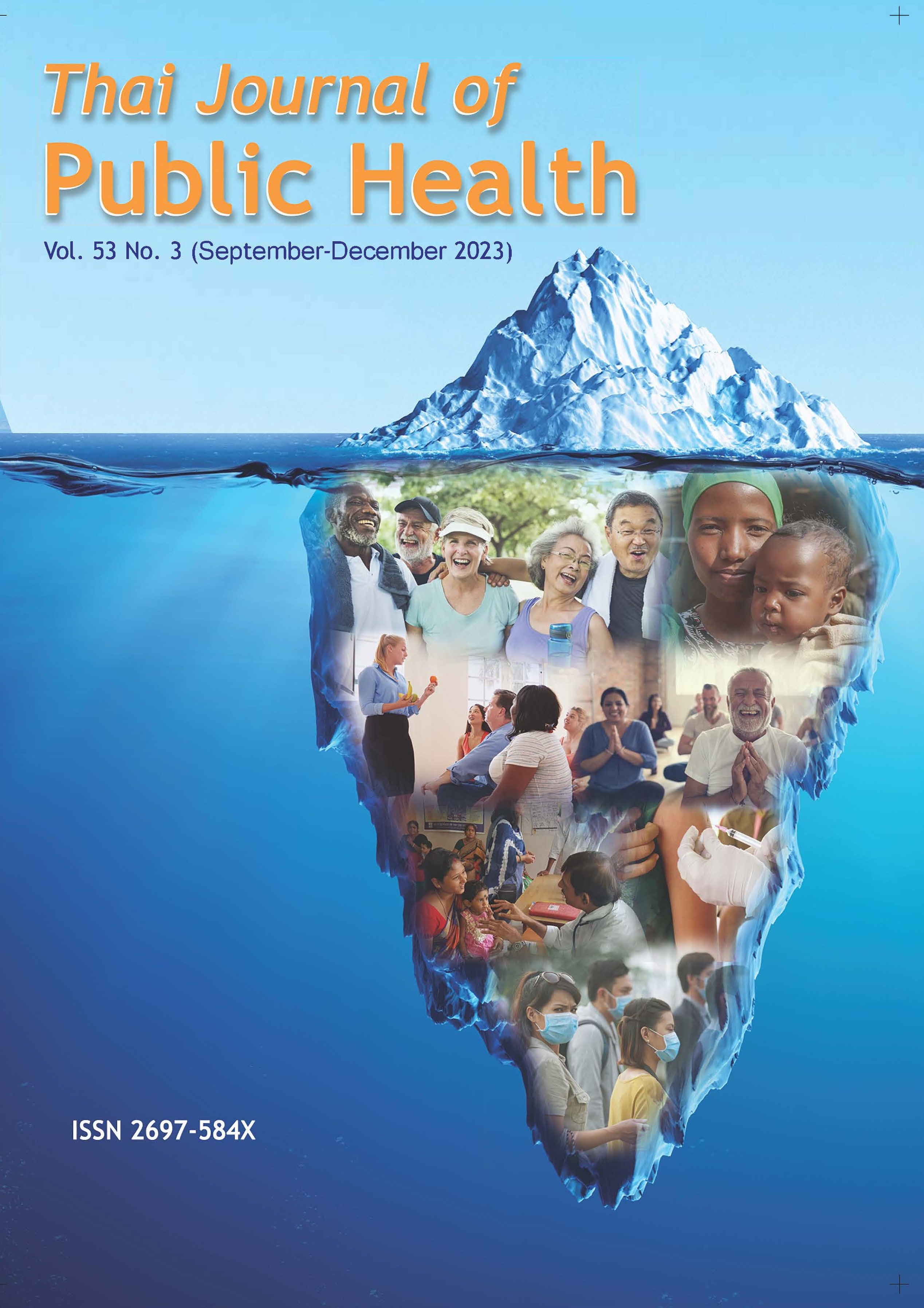Safety Culture Assessment in Three Automobile Assembly Plants in Thailand
Keywords:
Safety, Culture, Climate, Automobile assembly plantAbstract
The automotive industry in Thailand is at the turning point with digitalization, lean and advanced manufacturing technological development, transforming the structure and system that drive this industry. In the meantime, rapid change over assembly lines is forcing workers at risk of injury and illness from working with collaborative robots (cobots) and being exposed to dangerous machinery and chemicals. Objective: This study aimed to draw and compare the pictures of safety culture in three Japanese automobile assembly plants in Thailand, broadly recognized as a strong corporate safety culture. Method: This was a cross-sectional study conducted on three automobile assembly plants, with 719 respondents, mostly male 686 people (94.5 %). This study used the questionnaires which consist of two parts, personal data and the safety climate assessment developed by the UK Health and Safety Executive (HSE). Descriptive statistics were used to describe the safety climate score and the characteristics of the respondents. Inferential statistics were used to describe the comparison of personal factors, workplace location and find the correlation to the safety climate. Result: This study found that there was no shared vision of management commitment between the managers and subcontractors (p=0.04). The subcontractor perceived the safety rules and procedures differently compared to the manager (p = 0.001), supervisor, and operational staff (p = 0.00). In addition, the subcontractor’s perception of the work environment was different between the supervisor (p = 0.01) and operational staff (p = 0.04). The older workers perceived the safety rules and procedures differently compared to the younger generations (p = 0.00). The differences between Plant C compared with Plant A and B were communication, involvement, priority of safety, safety rules and procedures, supportive environment, and work environment (p = 0.00).
Conclusion: This study explored the differences factors that are embedded in these three plants by using the Safety Climate questionnaires. Recommendation: The method of this study can be applied to other corporates to perform multiple plants assessment to measure their safety climate periodically.
References
Thailand Board of Investment. Thailand’s Automotive Industry, The Next-generation. BOI Brochure, 2017. Available from: https://www.boi.go.th/index.php?page=business_opportunities_detail&topic_id=117517, accessed 10 July, 2021.
International Organization of Motor Vehicle Manufacturers (OICA). Production statistics. OICA statistics 2021, 2022. Available from: https://www.oica.net/category/production-statistics/2021-statistics/, accessed 20 May, 2022.
International Labor Organization. The future of work in the automotive industry: The need to invest in people’s capabilities and decent and sustainable work. 2021. Available from: https://www.ilo.org/sector/Resources/publications/WCMS_741659/lang--en/index.htm, accessed 9 June, 2022.
Social Security Office, Ministry of labor. Worker’s compensation fund annual report 2020. 2022. Available from: https://www.sso.go.th/wpr/main/privilege/%E0%B8%A3%E0%B8%B2%E0%B8%A2%E0%B8%87%E0%B8%B2%E0%B8%99_sub_category_list-label_1_130_717, accessed August, 2021. (In Thai).
Health and Safety Executive. Health and safety in automotive repair and associated industries. 2009. Available from: https://www.hse.gov.uk/pubns/priced/hsg261.pdf, accessed 10 June, 2019.
Reuters (Tokyo). Explosion hits Honda's plant in central japan, 2 workers hospitalized. Available from: https://www.reuters.com/article/us-honda-blast-idUSKBN23L07Q , accessed 5 May, 2022.
Daniel WW. Biostatistics: Basic concepts and methodology for the health. 2010. Available from: https://vdoc.pub/documents/biostatistics-a-methodology-for-the-health-sciences-747j10iugoe0, accessed 10 February, 2019.
Health and Safety Executive (HSE). Safety climate measurement user guide and toolkit. Available from:http://plataforma.responsable.net/sites/default/files/safety-climate-assessment-toolkit_1.pdf, accessed 10 May, 2021.
Gao Y, Bruce PJ, Rajendran N. Safety Climate of a commercial airline: A cross-sectional comparison of four occupational groups. Journal of Air Transport Management 2015; 47: 162-71. Available from: https://doi.org/10.1016/j.jairtraman.2015.05.010, accessed 10 February, 2019.
Cox S, Cheyne A. Assessing safety culture in offshore environments. Saf Sci. 2000; 34(1-3): 111- 29. DOI: 10.1016/S0925-7535(00)00009-6
O’ Toole M. Relationship between employee’s perception of safety and organization culture. Safety Research. 2002; 33(2): 231-43. DOI: 10.1016/S0022-4375(02)00014-2
Christopoulou A, Kouenenou K. General and technical high school: Demographic characteristics of student who choose either type of school. Procedia Soc Behav Sci. 2001; 30: 2235-40. DOI: 10.1016/j.sbspro.2011.10.436
Neal A, Griffin M. Safety climate and safety behavior. Australian Journal of Management 2002; 27: 67-5. DOI: 10.1177/031289620202701S08
Reiman T, Rollenhagen C. Does the concept of safety culture help or hinder systems thinking in safety?. Accid Ana Prev. 2014 Jul; 68: 5–15. DOI: 10.1016/j.aap.2013.10.033
Christian M, Bradley-Geist J, Wallace C, Burk M. Workplace safety: A meta-analysis of the roles of person and situation factor. Journal of Applied Phycology. 2009; 94(5): 1103-27. DOI: 10.1037/a0016172
Kouabenan D, Ngueutsa R, Mbaye S. Safety climate, perceived risk, and involvement in safety management. Saf Sci. 2015; 77: 72-9. DOI: 10.1016/j.ssci.2015.03.009
Guldenmund F. The Nature of safety culture: A review of theory and research. Saf Sci. 2000; 34(1): 215-57. DOI: 10.1016/S0925-7535(00)00014-X
Australia’s offshore energy regulator - National offshore safety and environmental authority. Human factors – safety culture. 2020. Available from: https://www.nopsema.gov.au/sites/default/files/documents/2021-03/A396120.pdf, accessed 2 February, 2022.
UK Health and Safety Executive – Research Report 367. A Review of safety culture and safety climate literature for the development of the safety culture inspection toolkit. 2005. Available from: https://www.hse.gov.uk/research/rrpdf/rr367.pdf, accessed 13 June, 2019.
Smith A, Wadsworth E. Safety culture, advice, and performance. IOSH Research Report 09.1. 2009. Available from: https://iosh.com/media/1547/safety-culture-advice-and-performance-full-research-report.pdf, accessed 2 June, 2021.
Grecco C, Vidal M, Cosenza C, Santos I, Carvalho P. Safety culture assessment: A fuzzy model for improving safety performance in a radioactive installation. progress in nuclear energy 2014; 70: 71-83. DOI: 10.1016/j.pnucene.2013.08.001
Riekert K, Ockene J, Pbert L. The handbook of health behavior change. Fourth Edition. 2014. Springer Publishing Company, New York.
Filho A, Waterson P. Maturity models and safety culture: A critical review. Saf Sci 2018; 105: 192-211. DOI: 0.1016/j.ssci.2018.02.017
Mather M, Lighthall N. Both risk and reward are processed differently in decisions made under stress. Curr Dir Psychol Sci. 2012 Feb; 21(2): 36-41. DOI: 10.1177/0963721411429452
Downloads
Published
Issue
Section
License

This work is licensed under a Creative Commons Attribution-NonCommercial-NoDerivatives 4.0 International License.
Creative Commons License CC-BY-ND


